How Many Grams in an Ounce? (g in oz)
How Many Grams in an Ounce? (g in oz)

- Ounces to Grams Converter (oz to g)
- How many grams in an ounce (g in oz). 1 ounce in grams
- Ounces to Grams Conversion – How Many Grams in an Ounce?
Grams and ounces are two distinct units of weight measurement. Grams are short-scale units of measurement, whereas ounces are longe
CHECK OUT SIMILAR POSTS…
This article discusses grams and ounces, as well as how to convert between them.
What is a Gram? How Many Grams in an Ounce?
Gram is a metric system mass unit. 1 gram = 0.03527396198 oz. The symbol is “g“.
How many grams in an ounce?
There are 28.349523125 grams in 1 ounce. To convert ounces to grams, simply multiply the ounce value by 28.349523125.
For instance, to know how many grams there are in a half ounce, just multiply 28.349523125 by 0.5, which makes 14.1747 grams in a half-ounce.
Ounces to grams formula
Gram = ounce * 28.349523125
How to convert grams to ounces?
1 Gram (g) is equal to 0.03527396198 ounces (oz). To convert grams to ounces, simply multiply the gram value by 0.03527396198 or divide by 28.3495231.
For instance, to convert 250 grams to oz, divide 250 by 28.3495231, which makes 8.81849 oz in 250 grams.
Grams to ounces formula
Ounce = gram * 0.03527396198
Ounce = gram / 28.349523125
How to convert grams to oz easily? How Many Grams in an Ounce?
Follow the formula to convert grams to ounces easily.
Weight in ounces = weight in grams / 28.34952
For instance, if you have 5 grams and want to convert them to ounces, you’ll get 0.17637 ounces by using this formula.
What is an Ounce? How Many Grams in an Ounce?
An ounce is an imperial system unit of mass. 1 Ounce = 28.349523125 Grams. 1 Troy ounce = 31.1034768 Grams. The symbol is “oz”
There are two main types of ounces: avoirdupois and troy. The troy ounce is the gold weight unit.
As a result, the answer to the question of how many grams are in an ounce may differ depending on the type of ounce converted.
When converting from avoirdupois ounces to grams, one ounce equals 28.349523125 grams.
If you’re weighing gold, you’re converting troy ounces to grams, and there are 31.1034768 grams in an ounce of gold.
The following is the list of conversion factors from ounces to grams:
- 1 Avoirdupois ounce = 28.349523125 grams
- 1 Troy ounce = 31.1034768 grams
How to Convert Ounces to Grams? How Many Grams in an Ounce?
What will you do if the recipe lacks a measurement? If the recipe does not include measurement, you can convert from cup to gram and then from gram to ounce.
For Illustration:
- Almond flour 1 Cup = 90g / 3.2 oz
- Grated Cheese 1 Cup = 113g / 4 oz
- Cornmeal 1 Cup = 120g / 4.2 oz
Common conversions from oz to grams
- 4 oz = 113.398093 grams
- 8 oz = 226.796185 grams
- 16 oz = 453.59237 grams
- 24 oz = 680.388555 grams
- 32 oz = 907.18474 grams
- 64 oz = 1814.36948 grams
Metric system: What is it and who uses it?
A metric system is a unit of measurement that is used all over the world.
It’s used by almost every country, except the United States, Liberia, and Myanmar. These countries make use of the customary system of units.
A metric system is a unit of measurement that is used all over the world.
In the metric system, for example, the dry weight is measured in grams while the measurement is done in ounces in the traditional system
American vs. Standard
Unlike other countries, the United States does not use grams to measure the weight of foods in recipes. They only use this unit when manufacturing food items or trading it on a global scale.
Apart from grams, a liter is a common unit that is used for manufacturing and trade.
In American recipes, the ingredients are written in ounces. Cups and tablespoons are the only unit of measurement for many recipes such as desserts, main courses, or breakfasts
However, if you live outside of the United States or want a more precise recipe, understanding the ounce to grams conversion is important.
Why Do I Need to Know How to Convert Grams to Ounces? How Many Grams in an Ounce?
Have you ever found a perfect recipe online or in a cookbook only to discover that the measurements differ from what you’re used to?
I understand how frustrating it can be. Knowing how to convert will come in handy in this situation. Recipes in the metric measurement system can be easily converted to US standard measurements.
It will be beneficial if you are familiar with this conversion because any excess or shortage in conversion can affect the outcome of your cooking.
Precision in measurement is important, and it begins with learning how to convert measurements.
You can, on the other hand, invest in digital scales to alleviate the stress of manual calculation.
How Many Grams in an Ounce? How Many Grams in an Ounce?
Almost every country outside of the United States uses the metric system, making it difficult for those who faced recipes that list ounces, cups, and/or tablespoons.
Fortunately, you can easily convert them to make cooking easier!
Let me show you the secret.
1 ounce (oz) is equal to 28.34952 grams (g):
1 oz = 28.34952 g
What does Ounce mean in Cooking?
An ounce is a standard weight measurement in the United States for dry ingredients.
The abbreviation for ounce is usually found on your packages (oz.). An ounce is typically equivalent to the weight of one slice of bread.
What does Gram mean in Cooking?
A gram is a unit of weight or mass in metric cooking measurement. It can be abbreviated as (g.) and is equivalent to the weight of a small paper clip.
What is the difference between an ounce and a gram? How Many Grams in an Ounce?
The measurement system used in the United States is known as Standard measurement. As a result, ingredients are measured in ounces, teaspoons, pounds, cups, and so on.
If you’re wondering what a dry ounce is, the answer is simple. One dry ounce weighs 28.35 grams, or 28.3495231 grams if you want to get fancy or go digit crazy
Dry ounces are weight measurements that are typically calculated by placing the material on a scale. Measuring fluid ounces, on the other hand, is more difficult.
Fluid ounces (abbreviated as fl. oz.) are all about volume, and volume requires knowledge of a material’s density for an accurate reading.
Take, for comparison purposes, two measuring cups. Fill one with jelly beans to the 1-cup line. Pour lemonade into the other cup, to the same 1-cup level. The two substances have different densities . . . and different weights.
How Many Grams in an Ounce Exactly?
An ounce contains 28 grams. The information provided below will assist you in converting between grams and ounces.
Cooking Weight Conversion Chart
The downloadable/printable version of my ounces to grams conversion chart is available here.
You can now keep this on your refrigerator for easy access while cooking!
Ounces to Grams conversion table
| Ounces (oz) | Grams (g) | Kilograms+Grams (kg+g) |
| 0 oz | 0 g | 0 kg 0 g |
| 0.1 oz | 2.835 g | 0 kg 2.835 g |
| 1 oz | 28.35 g | 0 kg 28.35 g |
| 2 oz | 56.70 g | 0 kg 56.70 g |
| 3 oz | 85.05 g | 0 kg 85.05 g |
| 4 oz | 113.40 g | 0 kg 113.40 g |
| 5 oz | 141.75 g | 0 kg 141.75 g |
| 6 oz | 170.10 g | 0 kg 170.10 g |
| 7 oz | 198.45 g | 0 kg 198.45 g |
| 8 oz | 226.80 g | 0 kg 226.80 g |
| 9 oz | 255.15 g | 0 kg 255.15 g |
| 10 oz | 283.50 g | 0 kg 283.50 g |
| 20 oz | 566.99 g | 0 kg 566.99 g |
| 30 oz | 850.49 g | 0 kg 850.49 g |
| 40 oz | 1133.98 g | 1 kg 133.98 g |
| 50 oz | 1417.48 g | 1 kg 417.48 g |
| 60 oz | 1700.97 g | 1 kg 700.97 g |
| 70 oz | 1984.47 g | 1 kg 984.47 g |
| 80 oz | 2267.96 g | 2 kg 267.96 g |
| 90 oz | 2551.46 g | 2 kg 551.46 g |
| 100 oz | 2834.95 g | 2 kg 834.95 g |
| 1000 oz | 28349.52 g | 28 kg 349.52 g |
How to measure dry weight?
A simple kitchen scale is the best way to measure dry weight (also known as a food scale).
It’s so simple to use—just press the ‘tare’ button to reset the scale to zero. You can then begin adding dry ingredients, and it will still provide an accurate weight.
If you want to measure butter, sugar, or flour (for cakes or brownies, for example), you’ll also need measuring spoons and cups.
When adding flour, sugar, or butter to measuring cups, press it with a flat tool or knife to remove any excess.
Then, using the kitchen scale, determine the dry weight of the container or measuring cup.


